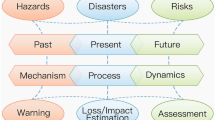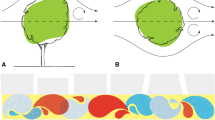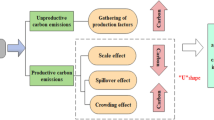Abstract
To clarify the current situation of haze emission and governance in China, the study analyzed the characteristics of spatial correlation structure and synergistic governance development of the haze emission of 31 provinces in China, based on social network analysis and distance synergistic model. The results indicated that the spatial correlation of inter-provincial haze emission in China presented a typical “central–marginal” network structure. The provinces in the network center were mostly located in the Beijing–Tianjin–Hebei region and the Yangtze River Delta region. The synergistic governance development of haze in China showed a lower level and fluctuating upward trend. In addition, the increase of network density, the decline of network grade, and the decrease of network efficiency would all improve the level of synergistic governance development. Therefore, focusing on the haze of the central provinces, improving the network structure, and improving regional synergy are important measures for effective governance. This paper improves the previous research model, considers the impact of economic and demographic factors on haze pollution, establishes a new model for analyzing spatial correlation structure of haze and calculating the synergistic governance level of haze, and designs feasible ways to raise the synergistic governance level of haze in China.





Similar content being viewed by others
References
Andersen ZJ, Raaschounielsen O, Ketzel M et al (2012) Diabetes incidence and long-term exposure to air pollution: a cohort study. Diab Care 35(1):92–98
Bertalanffy LV, 1969. General system theory: foundations, development, applications. G. Braziller
Borgatti SP, Mehra A, Brass DJ, Labianca G (2009) Network analysis in the social sciences. Science 323(5916):892–895
Carpenter A 2018. Oil pollution in the North Sea: the impact of governance measures on oil pollution over several decades. Hydrobiologia
Cassi L, Morrison A, Terwal ALJ (2012) The evolution of trade and scientific collaboration networks in the global wine sector: a longitudinal study using network analysis. Econ Geogr 88(3):311–334
Chen YG, Liu JS (2002) Derivation and generalization of the urban gravitational model using fractal idea with an application to the spatial cross-correlation between Beijing and Tianjin. Geogr Res 21(6):742–752
Chen H, Kwong JC, Copes R, Hystad P, van Donkelaar A, Tu K, Brook JR, Goldberg MS, Martin RV, Murray BJ, Wilton AS, Kopp A, Burnett RT (2017) Exposure to ambient air pollution and the incidence of dementia: a population-based cohort study. Environ Int 108:271–277
Ding G, Zhang B, Zhao P (2017) ESDA based spatial correlation features analysis of China urban regional haze pollution. Boletin Tecnico/Technical Bulletin 55(6):704–713
Filonchyk M, Yan H, Li X (2018) Temporal and spatial variation of particulate matter and its correlation with other criteria of air pollutants in Lanzhou, China, in spring-summer periods. Atmospheric Pollution Research 9:1100–1110
Groenewold N, Guoping L, Chen A (2010) Regional output spillovers in China: estimates from a VAR model. Pap Reg Sci 86(1):101–122
Guo J (2014) Study on carbon emission and reduction measure of industrial sector based on network analysis method. Technol Econ 33(7):90–95
Hart JE, Puett RC, Rexrode KM et al (2015) Effect modification of long-term air pollution exposures and the risk of incident cardiovascular disease in US women. J Am Heart Assoc 4(12):e002301
Head, K., 2003. Gravity for beginners. University of British Columbia
Hou YH, Liu ZB, Yue ZG (2009) Social network analysis over the process of economic integration in the Yangtze River Delta. China Soft Sci 45(12):90–101
Isard, W., 1956. Location and space-economy. M.I.T. Press 363
Lee S (2017) Japanese measurement on fine particles (PM2.5) emission pollution and cooperation. Environ Resour Econ Rev 26(1):57–83
Li L, Niu TY (2017) The spatial linkage network structure of regional innovation output—based on the social network analysis. Econ Geogr 37(09):19–25+61
Li J, Chen S, Wan GH, Fu CM (2014a) Study on the spatial correlation and explanation of regional economic growth in China—based on analytic network process. Econ Res J 49(11):4–16
Li HD, Wang S, Liu Y (2014b) Evaluation method and empirical research of regional synergetic development degree based on grey relational theory and distance collaborative model. Syst Eng-Theory Pract 34(7):1749–1755
Li J, Fan C, Yuan Q (2017) Synergetic development degree evaluation of Beijing-Tianjin-Hebei region based on distance collaborative model. Sci Technol Manag Res 37(18):45–50
Li BT, Guo HM, Wu HM (2018) Research on the influencing factors of ESCO dynamics in the development of existing building energy-saving reconstruction market based on SNA. Sci Technol Progress Policy 35(24):150–154
Li H, Song Y, Zhang M (2018a) Study on the gravity center evolution of air pollution in Yangtze River Delta of China. Nat Hazards 90(3):1447–1459
Li M, Li C, Zhang M (2018b) Exploring the spatial spillover effects of industrialization and urbanization factors on pollutants emissions in China’s Huang-Huai-Hai region. J Clean Prod 195:154–162
Lin XQ, Wang D (2016) Spatio-temporal variations and socio-economic driving forces of air quality in Chinese cities. J Geogr Sci 26(11):1533–1549
Liu YB, Dai L (2013) Economic contact analysis with network structure of urban agglomeration around the Poyang Lake based on SNA. Resour EnvironYangtze Basin 22(3):263–271
Liu H, Du G 2018. Research on spatial correlation of haze pollution in China. Statistical Research
Liu HJ, Pei YF, 2017. An empirical test of the environmental Kuznets curve of China’s haze pollution. Stat Res (3): 45–54
Liu HJ, Liu CM, Sun YN, et al., 2015. Spatial correlation network structure of energy consumption and its effect in China. China Ind Econ (5):83–95
Newton I Sir, et al., 2007. Mathematical principles of natural philosophy. Dawsons
Poyhonen PA (1963) Tentative model for the volume of trade between countries. Weltwirtschaftliches Arch 90:93–100
Ravenstein EG (1885) The laws of migration. J Stat Soc Lond 48(2):167–235
Reilly WJ, 1929. Methods for the study of retail relationships//methods for the study of retail relationships. University of Texas
Schiavo S (2010) International trade and financial integration: a weighted network analysis. Quant Finan 10(4):389–399
Shao S, Li X, Cao J, et al., 2016. China’s economic policy choices for governing smog pollution based on spatial spillover effects. Econ Res J (9):73–88
Sun YN, Liu HJ, Liu CM, Cui R, 2016a. Research on spatial association of provinces carbon emissions and its effects in China. Shanghai J Econ (2):82–92
Sun YN, Liu HJ, Liu CM, et al., 2016b. Research on spatial association of provinces carbon emissions and its effects in China. Shanghai J Econ (2):82–92
Taaffe EJ (1962) The urban hierarchy: an air passenger definition. Econ Geogr 38(1):1–14
Tang FH, Tang H, Sun Q et al (2013) Analysis of the economic network structure of urban agglomerations in the middle Yangtze River. Acta Geograph Sin 68(10):1357–1366
Tinbergen J 1962. An analysis of world trade flows in shaping the world economy. Edited by Jan Tinbergen New York NY: Twentieth Century Fund
Tong Z, Chen Y, Malkawi A, Liu Z, Freeman RB (2016) Energy saving potential of natural ventilation in China: the impact of ambient air pollution. Appl Energy 179:660–668
Van DA, Martin RV, Brauer M et al (2016) Global estimates of fine particulate matter using a combined geophysical-statistical method with information from satellites, models, and monitors. Environ Sci Technol 50(7):3762
Wang WQ 2014. The research on cooperative governance of air pollution:based on the case of Beijing area. J Public Manag (1):55–64
Wang DZ, Zhuang RX, 1996. The preliminary probe into the quantitative analysis of regional economic links—a case study on economic links between Su-Xi-Chang and Shanghai. Sci Geogr Sin (01):51–57
Wang X, Wu DT, Wang HQ, 2006. An attempt to calculate economic links between cities. Urban Stud (03):55–59
Waters N 2014. Social network analysis. Springer Berlin Heidelberg
Wu CY, Huang XJ, Chen BW et al (2017) Analysis of economic and spatial linkage and economic integration trend in Yangtze River economic belt from social network analysis perspective. Econ Geogr 37(07):71–78
Xie Y, Zhao L, Jian X et al (2016) A cooperative reduction model for regional air pollution control in China that considers adverse health effects and pollutant reduction costs. Sci Total Environ 573:458–469
Yang WY (1989) Principle of location theory. Gansu People’s Publishing House, Lanzhou
Zhang M, Li H (2018) New evolutionary game model of the regional governance of haze pollution in China. Appl Math Model 63:577–590
Zhang DG, Lu YQ (2017) Study on the spatial correlation and explanation of carbon emission in China—based on social network analysis. Soft Sci 31(4):15–18
Zhang Z, Hao Y, Lu ZN (2018) Does environmental pollution affect labor supply? An empirical analysis based on 112 cities in China. J Clean Prod 190(20):378–387
Zheng GH, 2010. Evaluation system on harmony development of regional innovation system. Chin J Syst Sci (3):76–79
Zipf GK (1946) The P1P2/D hypothesis: on the intercity movement of persons. Am Sociol Rev 11(6):677–686
Acknowledgments
The authors gratefully acknowledge the financial support from the National Natural Science Foundation of China (71874189, 71774158, 71804182), China’s Post-doctoral Science Fund (2015M580484, 2016T90517), Jiangsu Social Science Fund (18JD013, 16JD008), High-Level Talents Project of “Six Talents Peaks” in Jiangsu Province (JY-077), and Qinlan Project of Jiangsu. We also would like to thank the anonymous referees for their helpful suggestions and corrections on the earlier draft of our paper, and upon which we have improved the content.
Author information
Authors and Affiliations
Corresponding authors
Additional information
Responsible editor: Philippe Garrigues
Publisher’s note
Springer Nature remains neutral with regard to jurisdictional claims in published maps and institutional affiliations.
Rights and permissions
About this article
Cite this article
Li, H., Zhang, M., Li, C. et al. Study on the spatial correlation structure and synergistic governance development of the haze emission in China. Environ Sci Pollut Res 26, 12136–12149 (2019). https://doi.org/10.1007/s11356-019-04682-5
Received:
Accepted:
Published:
Issue Date:
DOI: https://doi.org/10.1007/s11356-019-04682-5




